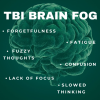Chronic Traumatic Encephalopathy (CTE) is a neurodegenerative brain disease that results from repeated blows to the head. It is a progressive disease: once it is triggered, it will worsen with aging. CTE has been found in many athletes, military veterans, and other individuals with a history of repetitive head traumas. Symptoms of CTE do not generally appear until years after the onset of head traumas, but they can vary from person to person. Different symptoms also appear in 4 stages.
| Stages of CTE | Symptoms |
| I |
|
| II |
|
| III & IV |
|
Other symptoms include:
- Personality changes
- Aggression
- Difficulty concentrating
- Impaired executive functioning (i.e., planning, organizing, problem-solving)
- Dysphagia (difficulty swallowing)
- Hypomimia (reduced facial movement and expression)
- Ptosis (drooping eye)
CTE can only be diagnosed after death. There is currently no treatment or cure for CTE. However, avoiding repeated head injuries or traumas can help prevent CTE. There are also general strategies individuals can use to manage symptoms of CTE. These include:
- Yoga or meditation to treat anxiety or depression
- Using memory aids (i.e., phone reminders, calendar, planner)
- Engaging in brain games or exercises (i.e., via mobile apps) to improve executive functioning
- Using compensatory strategies (i.e., wrist weights) to manage tremors
- Pain management (i.e., heat or ice packs) to treat headaches
References:



